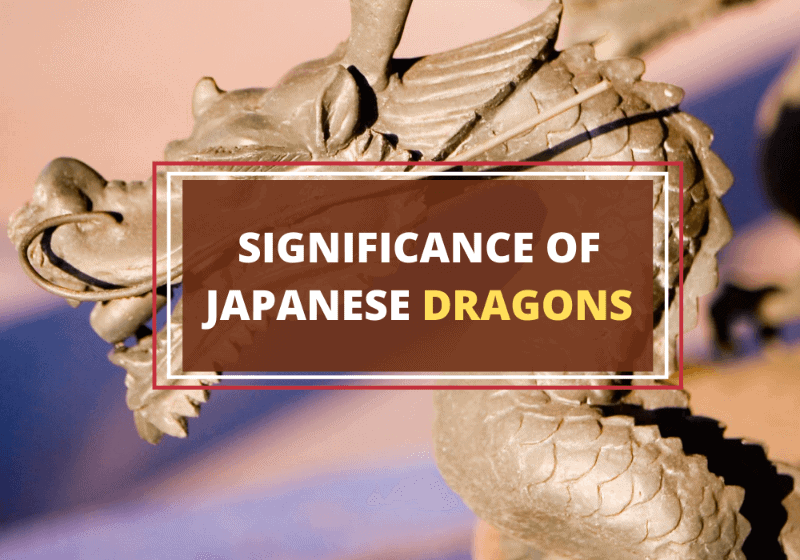
Table of Contents
Japanese dragon myths are both strongly inspired by Chinese and Hindu dragon myths, and still very much unique. It’s fair to say that Japanese mythology has one of the most diverse collections of dragon types, variations, myths, meanings, and nuances.
Whereas in most other cultures, dragons are seen as either always evil creatures that have to be slain by the hero or always benevolent and wise spirits, in Japanese mythology, dragons are more complex, often exhibiting characteristics of both good and evil.
Let’s take a closer look at Japanese dragons and why they’re so popular.
Types of Japanese Dragons
The dragons of Japanese myths are powerful beings that control water and rains, and are believed to live in bodies of water, like rivers or lakes. The two main types of Japanese dragons include:
- Japanese Water Dragon – this type of dragon is similar to the Chinese dragon and is found in sources of water. Called Mizuchi, the water dragin is long and serpent-like, and is believed to have been a water deity.
- Japanese Sky Dragon – these dragons were said to live in the clouds or in the heavens, and didn’t have a special connection to water.
Chinese vs. Japanese Dragons
We can’t talk about Japanese dragons before first examing the influence of Chinese and Korean dragons and myths on the Japanese culture. The various words for dragon in Japanese are written with Chinese kanji letters.
Many of the dragons in Japanese mythology are similar in both appearance and meaning to the classic Chinese Lung dragons.
- They are viewed as benevolent water spirits that live in the sea or rivers
- They are believed to bring luck and symbolize power, strength, and authority.
- Physically, they have elongated serpentine bodies with two or four short legs or no legs at all.
- When they have wings, they are small and bat-like, just like those of their Chinese counterpart.
One of the few physical differences between Chinese and Japanese dragons is that Chinese dragons have four or five claws on their feet with five-clawed dragons being viewed as more powerful and regal, while in Japan mythology, most dragons have only three claws on their feet.
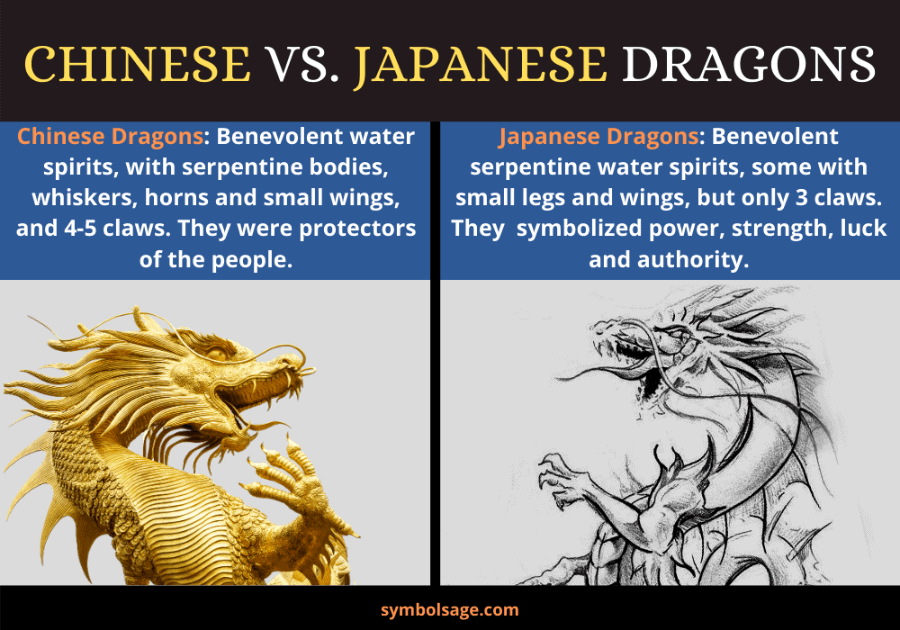
China and Japan even share many specific dragon myths and characters. The astrological Four Symbols are a good example:
- The Azure Dragon – named Seiryū in Japan and Qinglong in China
- The White Tiger dragon – named Byakko in Japan and Baihu in China
- The Vermilion Bird dragon – named Suzaku in Japan and Zhuque in China
- The Black Tortoise dragon – named Gembu in Japan and Xuanwu in China.
The four dragon kings of the east, south, west, and north seas are another touching point between the two cultures, existing in both cultures.
However, not all Japanese Lung-like dragons are directly taken from Chinese myths. Most other Japanese dragons have their own myths and characters, even if their visual appearance and overall meaning is inspired by Chinese legends.
Hindu-Japanese Dragons
Another great influence on Japanese dragon mythology comes from the Hindu Nāga myths even though they arrived in Japan through Buddhism, which itself was also strongly inspired by the Hindu Nāga dragons.
The Nāga (or plural Nāgi) were different from what people in the west usually associate with dragons but are counted as such nevertheless. These bizarre creatures typically had half-human and half-snake bodies with long tails. They could also often transition between fully human or fully serpent forms and had multiple open-hooded cobra heads, sometimes in addition to their human heads.
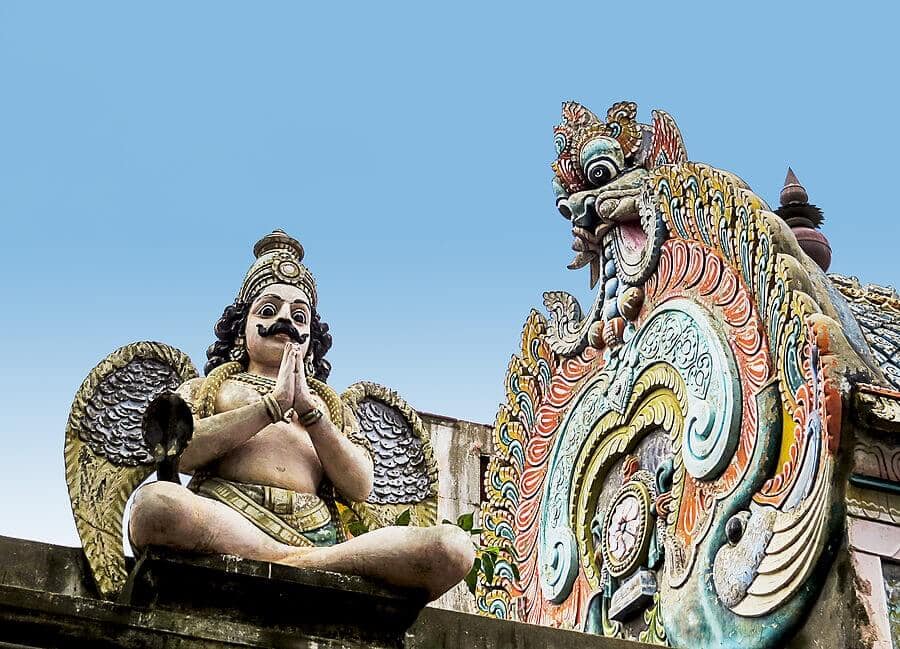
The Japanese Nāgi were also believed to control the ebb and flow of the sea’s tides through the “tide jewels” they had in their underwater castles. In Hinduism, the Nāgi are typically benevolent or morally neutral sea-dwelling and semi-divine creatures with powerful and rich underwater civilizations.
In Japanese mythology, however, the Nāga are a bit different.
There, these mythical creatures are worshipped as rain deities similar to how Lung dragons are worshipped in Chinese mythology. The Nāgi are also viewed as protectors of Buddhism and the underwater palaces they live in are more so inspired by Chinese dragons’ palaces rather than those of the original Hindu Nāgi.
The reason for that is simple:
While the Nāga myths originated in Hinduism, they came to Japan through Chinese Buddhism so the Nāga and Lung dragon myths are intertwined in Japan.
Classic Japanese Dragons
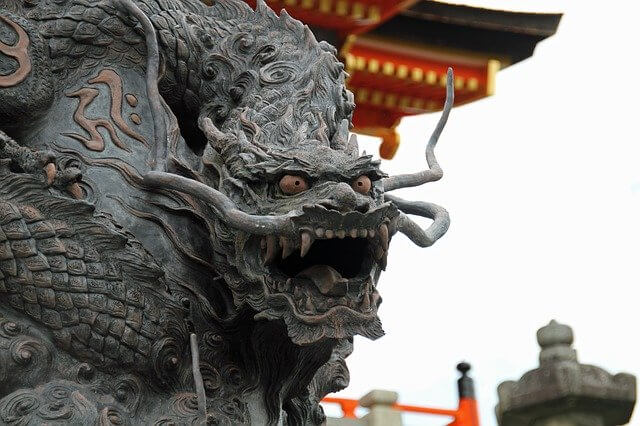
What makes Japanese dragon myths truly unique, however, are the many indigenous dragon myths in Japanese culture. Once the Hindu Nāga and Chinese Lung dragon myths became popular in Japan, many other myths were quickly invented in addition to them, and those are where Japanese creativity, culture, and unique morality are easily visible.
The main unique characteristic of many of the indigenous Japanese dragon myths is the “humanity” given to these creatures. Whereas in most other mythologies they are either evil monsters or benevolent spirits, in Japan dragons are much more human and often demonstrate human emotions and experiences.
Popular Japanese Dragons
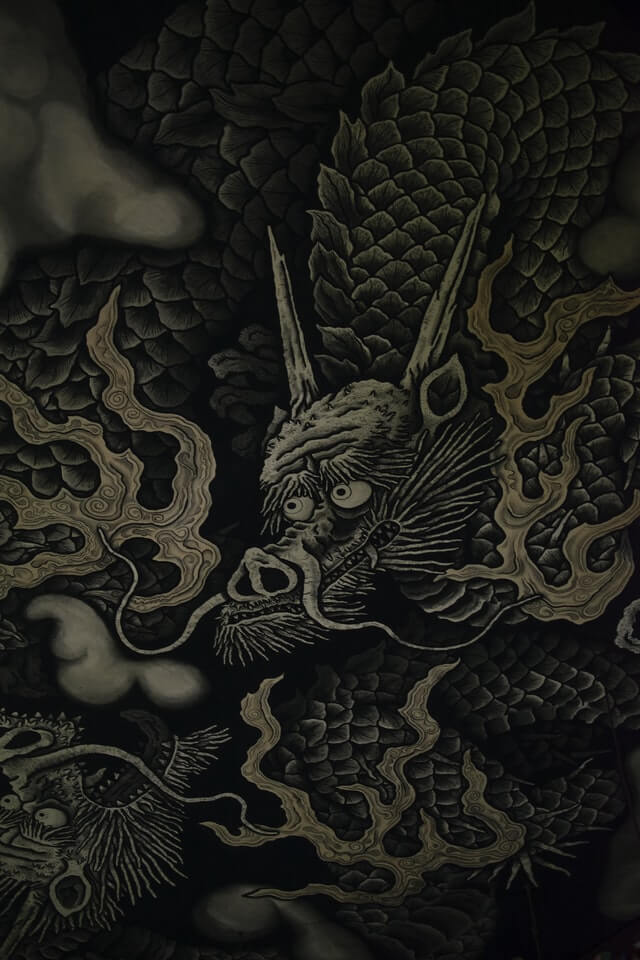
In Japanese myths, dragons often fall in love, mourn losses, experience sorrow, and regret, and seek redemption or retribution. Here are some of the most popular Japanese dragons.
- Ryūjin is one of the most important of all Japanese dragons, as he was the deity of the sea. He represented the power of the ocean and was a patron of Japan. Considering that the sea and seafood are important for Japanese livelihood, Ryūjin plays a significant role in Japanese culture and history. In fact, he’s believed to be one of the forefathers of the Japanese imperial dynasty.
- Kiyohime, also known as the Purity Princess, was a teahouse waitress who fell in love with a Buddhist priest. After the priest denied her love, however, Kiyohime started to study magic, turned herself into a dragon, and killed him.
- Yamata no Orochi is a mythical monster-like Japanese dragon that had eight heads and tails. It was slain by Susano-o to save Kushinada-Hime and win her as his bride.
- In another myth, the fisherman Urashima Tarō rescued a turtle from the sea but the animal took the fisherman to the underwater dragon palace Ryūgū-jō. Once there, the turtle transformed into the attractive daughter of the ocean dragon god, Ryūjin.
- Benten, the Buddhist patron goddess of literature, wealth and music, married a sea dragon king to prevent him from ravaging the land. Her compassion and love changed the dragon king, and he stopped terrorizing the land.
- The O Goncho was a white Japanese dragon, that lived in a deep pool of water. Every fifty years, the O Goncho transformed into a golden bird. It’s cry was a sign that famine and distruction would come to the land. This dragon myth brings to mind the story of the phoenix.
These and many other humanized dragon myths exist in Japanese mythology alongside the more standard representations of dragons as benevolent spirits or powerful monsters.
Japanese Dragon Facts
They are called ryū or tatsu.
Ryujin refers to the dragon king and lord of the serpents in Japanese mythology.
They’re usually depicted as living in bodies of water, the sea or in the clouds.
It only has 3 whereas Chinese dragons have 4 or 5. This is the main difference between Chinese and Japanese dragons.
There are depictions of both good and evil dragons in Japanese mythology. Chinese influence resulted in a more positive depiction of dragons as benign and beneficial beings.
Wrapping Up
Japanese mythology is rich with stories in which dragons play central roles. Sometimes depicted as human-like and often intermarrying with humans, Japanese dragons are unique and intriguing characters that continue to be popular.








